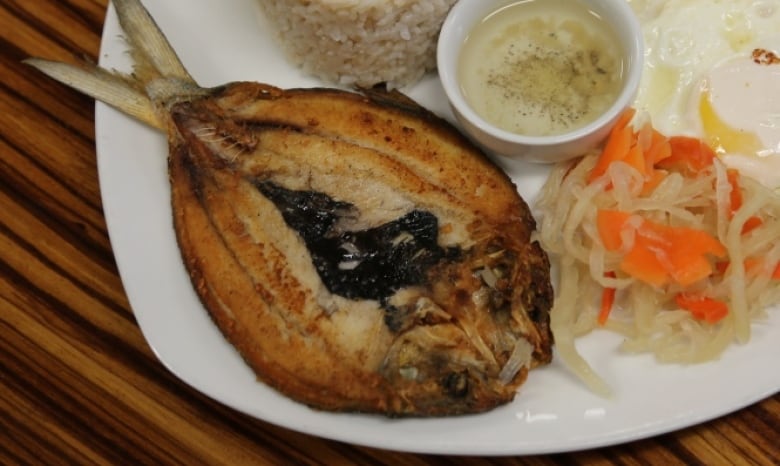Why food is much more than just food in Filipino culture
It can help keep the peace and provide a sense of connection in difficult times

"Have you eaten yet?" is a common greeting in Filipino homes, often taking the place of "How are you?"
Many Filipinos will tell you it's the first question that's asked when a loved one walks in the door, because, culturally, food is much more than just something to eat.
"Food can be its own language of love and appreciation, or even its own apology, in a sense," said Michael Juarez, a culinary graduate of SAIT in Calgary.
It's one of the most basic human needs, and sharing a meal is often considered a central aspect of home life and family relationships. At a table where grandparents, parents and children come with their different values and expectations, food can be common ground and peacemaking.
Food keepsthe peace
"Sometimes the words 'I love you,' 'I'm proud of you,' or 'I'm happy for you' sometimes it's just so hard to say them because of past histories and family struggles," said Juarez.
Juarez says he's heard those unspoken words often through food, on occasions where he would come downstairs to see a pot of one of his favourite dishes, just sitting on the stove with no explanation.

"It doesn't matter if you're not listening to what [your parents] want, that you didn't take the right courses, that you should have been a nurse or a doctor, or you shouldn't have taken digital marketing, or whatever the scenario is," Juarez said.
"At the end of the day, they'll still prepare food for you," he said.
"Filipino food to me was always a great place where you can always come together, talk as a family."
Food can keep the peace. But because it's so laden with meaning, it can also bring cultural tensions to a head.
'Why? What's wrong with my food?'
Food can be a form of cultural expression even within families.It can become infused with history and the transmission of heritage and identity.
So when a particular dish isn't enjoyed, a clash of cultures can quickly arise.
As a second generation Filipino Canadian born in Calgary, Jesie Salcedo was exposed to a variety of cuisines that shaped her palate.
"There were certain foods when I was growing up, that, if I didn't eat them, I was always perpetuated as whitewashed because I wouldn't touch it," said the 27-year-old.

Foods like daing or tuyo, kinds of dried fish, or pinakbet, which features a fermented shrimp paste, were things her parents had grown up eating in the Philippines.
But they weren't to Salcedo's taste, and that was sometimes difficult for her parents to accept.
"I think it stems back from the fact that our moms and our titas (aunts)invest so much in their food that, when we reject even a part of it, it hurts," said Salcedo.
It was the same forJuarez, who as a kid would ask his parents for a ham sandwich or a peanut butter and jelly to bring to school.
"And I remember my mom said, "Why? What's wrong with my food? You're going to eat the food that I prepared for you."
So he'd head off to school with his fork and spoon, and his lovingly prepared rice-based meal.
Yet where food can create tension, it can also reduce it.
Familiar foods can create a sense of home
Salcedo says it's the pandesal, or bread rolls, that her mother is most proud of. Sometimes, that's what her mother would quietly bring up to her room to make amends.

"If we get into an argument, that's usually how she forms a truce," Salcedo said.
Like many of the other dishes that her mother has made for her over the years, they remind her of home, and they remind her she's loved.
And so, last year, in the middle of the physical distancing of the pandemic, Salcedo started to learn to make traditional Filipino foods such assinigang (a sour savoury soup), spring rolls, and desserts like champorado (chocolate rice pudding) and ginataan (a sweet, coconut milk-based soup).
She says it was a way for her to experience some sense of togetherness.

"I was just gravitating towardthat feeling of wanting to be at home, to feel like I was connected with something," she said.
Eating them helped her feel closer to home and loved ones, even though, she says, they weren't as good as her mom's.
And that's one of themore fun aspects of making food: the competition.

''Their identity was in that dish'
Salcedo and Juarez say it's common in Filipino circles for there to be friendly teasing at get-togethers, about who makes what, and who makes it better.
You'll often hear people say things like, "No one makes this as well as tita so-and-so," or, "Your dad's adobo is not as good as my dad's," saidJuarez.
Staple dishes are prepared differently in each family, depending on what region of the Philippines the cook is from, and what they grew up eating. The same dish can be a different colour or consistency, and it can pack a different level of heat or acidity, depending on who made it and for whom.
That's what makes food so intimate, Juarez says.
"When you're eating the food from your mom or from your lola(grandmother), their identity was in that dish. The heart and essence of that dish was your mom, or your grandparents."













_(720p).jpg)


 OFFICIAL HD MUSIC VIDEO.jpg)
.jpg)



























































































